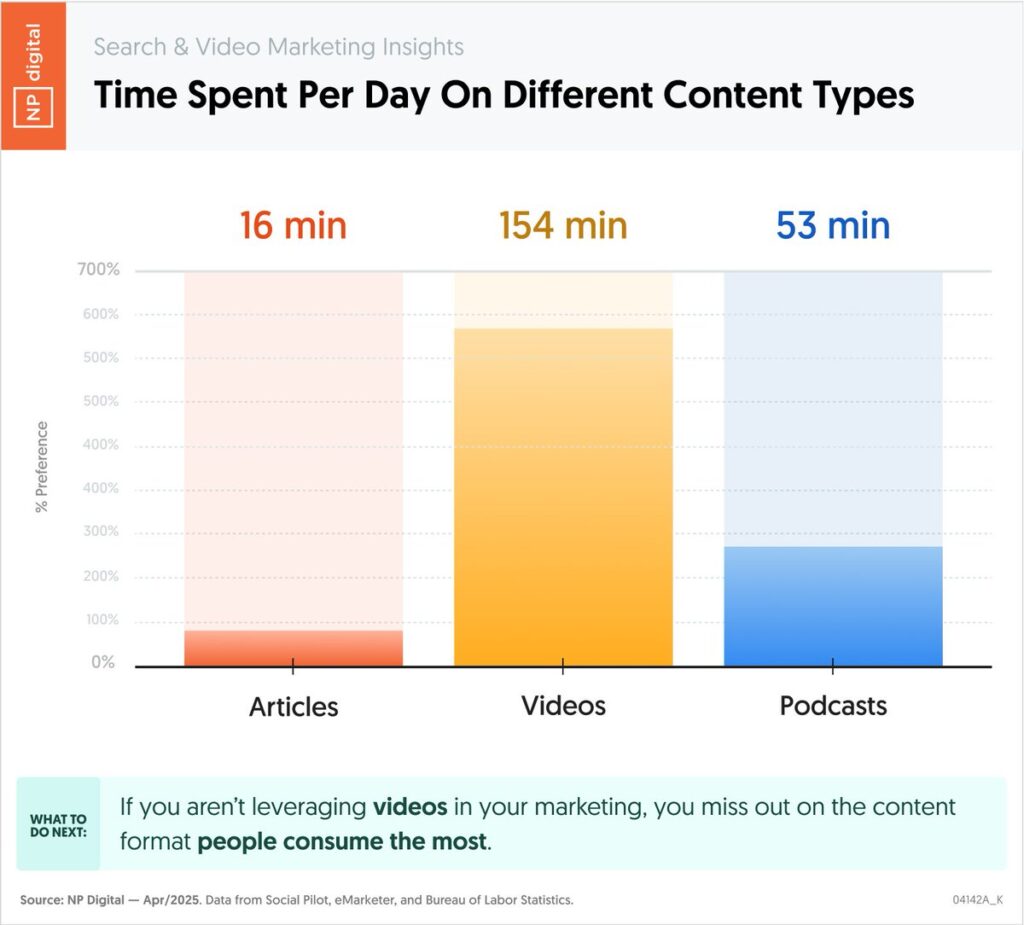The data-driven case for putting video at the heart of your content strategy
A few days ago, I shared the infographic below on X — originally published by Neil Patel — showing how much time people spend each day with different types of content.

📊 Articles: 16 minutes
📊 Podcasts: 53 minutes
📊 Videos: 154 minutes
The response was immediate.
Several people got in touch to say: “Sure, video might be the most consumed — but in my experience, written content still converts best.”
It’s a fair challenge. After all, written content is the foundation of SEO, lead generation, and thought leadership. But I wanted to see what the broader data actually says — not just about attention, but about conversion.
So I took a deep dive into the latest research. And the results are, frankly, eye-opening.
Video Is No Longer Just About Engagement — It’s About Conversion
Let’s begin with what we know: consumers now spend an average of 2 hours and 25 minutes per day watching online video (DataReportal, 2025). That’s more than podcast listening, more than reading articles — and for many demographics, more than watching television.
But what matters more is this: they’re not just watching. They’re buying.
- 70% of TikTok users say they find it easy to shop directly through in-video ads
- 1 in 4 viewers has purchased a product after watching a TikTok beauty video (TikTok Marketing Science, 2024)
On the open web, the pattern holds.
Landing pages with video convert up to 86% better than those without (Eyeview Digital)
Interactive product videos can boost conversion by up to 70% (Vidyard Benchmark Report, 2024)
This isn’t a niche advantage. It’s a performance gap that’s becoming harder to ignore.
Why Video Converts: Format Matters
Video simplifies decision-making.
A single 30-second video can do the job of an article, testimonial, and product tour all at once. It shows the product, tells the story, and invites the viewer to take action — often without ever leaving the platform.
- 89% of consumers say video convinced them to buy
- 96% of marketers say video improves customer understanding (Wyzowl, 2024)
The difference is that video is emotional. It builds trust faster, and trust — not traffic — is what drives conversions.
We live in an attention economy. People scan text, but they feel video.
From Awareness to Action
One of the great myths in content marketing is that video is mainly a top-of-funnel tool — good for reach, not for action.
That’s no longer true.
According to Nielsen, video ads focused on brand-building can increase purchase intent by 60% (Nielsen Media Impact, 2023).
And in B2B?
- 70% of decision-makers watch videos during the buying process
- 52% say they’re more likely to buy after consuming content from a brand (Demand Gen Report, 2024)
Video is now both the opener and the closer. It attracts attention and seals the deal. That dual capability is rare — and it’s one of the reasons marketers are placing video at the core of their content strategy.
The Rise of Shoppable Media
Where this is all heading is toward frictionless commerce — and video is leading the charge.
Every major platform is building tools to let people buy within the video:
– TikTok Spark Ads
– YouTube Shorts with embedded links
– Instagram Reels with product tags
And the results?
Brands using shoppable video are seeing 3–5× higher conversion rates than traditional ecommerce (Shopify Plus Insights, 2024)
This is particularly true in beauty, fashion, and fitness — but it’s also expanding into software, homeware, and even B2B demos.
The point is: video is no longer just influencing purchases. It’s facilitating them.
So Why Aren’t More Brands Doing This?
The data is clear. The platforms are ready. The tools are easier than ever. And yet, most brands are still under-investing.
Only 36% of marketers say they’re using video to its full potential
(HubSpot State of Marketing, 2024)
Why? Because video feels more complex. It seems more expensive. And many teams are still wired for copy-first workflows.
But that’s changing — fast. With AI tools like Runway, Descript, CapCut and Canva, you no longer need a full production crew. What you need is a plan.
A strategy that puts video not on the edges, but at the centre.
Conclusion
Content marketing used to be about visibility. Today, it’s about velocity — how quickly you can earn trust and convert attention into action.
Video is built for that.
It’s the format people spend the most time with. It’s the format they trust. And it’s the format that delivers measurable results.
In that context, it’s no longer enough to simply “have a few videos.” The brands winning in 2025 are the ones putting video at the core of how they sell, explain, and connect.
The question isn’t whether video converts better.
It’s whether your content strategy reflects that.
Leave a Reply